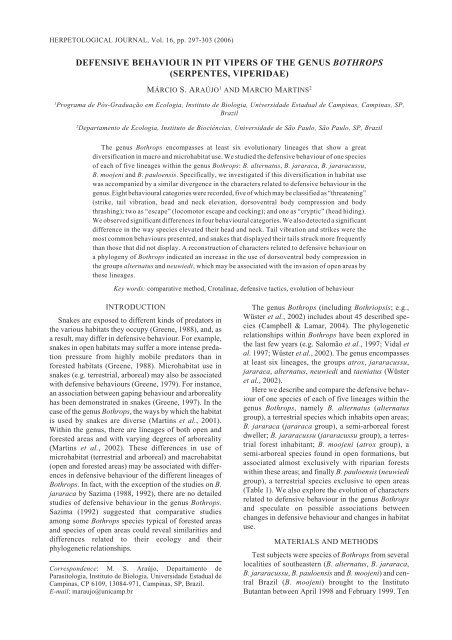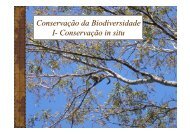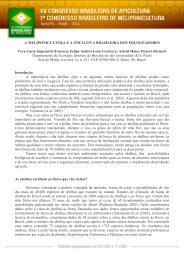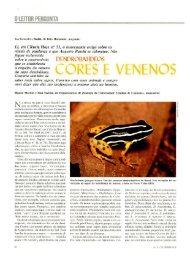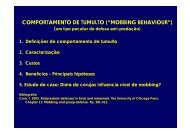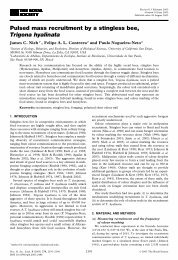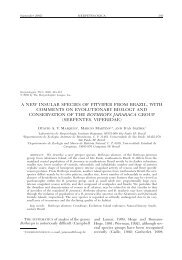Araujo & Martins pp 297-303.pmd - Ecologia
Araujo & Martins pp 297-303.pmd - Ecologia
Araujo & Martins pp 297-303.pmd - Ecologia
Create successful ePaper yourself
Turn your PDF publications into a flip-book with our unique Google optimized e-Paper software.
HERPETOLOGICAL JOURNAL, Vol. 16, <strong>pp</strong>. <strong>297</strong>-303 (2006)<br />
DEFENSIVE BEHAVIOUR IN PIT VIPERS OF THE GENUS BOTHROPS<br />
(SERPENTES, VIPERIDAE)<br />
MÁRCIO S. ARAÚJO 1 AND MARCIO MARTINS 2<br />
1<br />
Programa de Pós-Graduação em <strong>Ecologia</strong>, Instituto de Biologia, Universidade Estadual de Campinas, Campinas, SP,<br />
Brazil<br />
2<br />
Departamento de <strong>Ecologia</strong>, Instituto de Biociências, Universidade de São Paulo, São Paulo, SP, Brazil<br />
The genus Bothrops encompasses at least six evolutionary lineages that show a great<br />
diversification in macro and microhabitat use. We studied the defensive behaviour of one species<br />
of each of five lineages within the genus Bothrops: B. alternatus, B. jararaca, B. jararacussu,<br />
B. moojeni and B. pauloensis. Specifically, we investigated if this diversification in habitat use<br />
was accompanied by a similar divergence in the characters related to defensive behaviour in the<br />
genus. Eight behavioural categories were recorded, five of which may be classified as “threatening”<br />
(strike, tail vibration, head and neck elevation, dorsoventral body compression and body<br />
thrashing); two as “escape” (locomotor escape and cocking); and one as “cryptic” (head hiding).<br />
We observed significant differences in four behavioural categories. We also detected a significant<br />
difference in the way species elevated their head and neck. Tail vibration and strikes were the<br />
most common behaviours presented, and snakes that displayed their tails struck more frequently<br />
than those that did not display. A reconstruction of characters related to defensive behaviour on<br />
a phylogeny of Bothrops indicated an increase in the use of dorsoventral body compression in<br />
the groups alternatus and neuwiedi, which may be associated with the invasion of open areas by<br />
these lineages.<br />
Key words: comparative method, Crotalinae, defensive tactics, evolution of behaviour<br />
INTRODUCTION<br />
Snakes are exposed to different kinds of predators in<br />
the various habitats they occupy (Greene, 1988), and, as<br />
a result, may differ in defensive behaviour. For example,<br />
snakes in open habitats may suffer a more intense predation<br />
pressure from highly mobile predators than in<br />
forested habitats (Greene, 1988). Microhabitat use in<br />
snakes (e.g. terrestrial, arboreal) may also be associated<br />
with defensive behaviours (Greene, 1979). For instance,<br />
an association between gaping behaviour and arboreality<br />
has been demonstrated in snakes (Greene, 1997). In the<br />
case of the genus Bothrops, the ways by which the habitat<br />
is used by snakes are diverse (<strong>Martins</strong> et al., 2001).<br />
Within the genus, there are lineages of both open and<br />
forested areas and with varying degrees of arboreality<br />
(<strong>Martins</strong> et al., 2002). These differences in use of<br />
microhabitat (terrestrial and arboreal) and macrohabitat<br />
(open and forested areas) may be associated with differences<br />
in defensive behaviour of the different lineages of<br />
Bothrops. In fact, with the exception of the studies on B.<br />
jararaca by Sazima (1988, 1992), there are no detailed<br />
studies of defensive behaviour in the genus Bothrops.<br />
Sazima (1992) suggested that comparative studies<br />
among some Bothrops species typical of forested areas<br />
and species of open areas could reveal similarities and<br />
differences related to their ecology and their<br />
phylogenetic relationships.<br />
Correspondence: M. S. Araújo, Departamento de<br />
Parasitologia, Instituto de Biologia, Universidade Estadual de<br />
Campinas, CP 6109, 13084-971, Campinas, SP, Brazil.<br />
E-mail: maraujo@unicamp.br<br />
The genus Bothrops (including Bothriopsis; e.g.,<br />
Wüster et al., 2002) includes about 45 described species<br />
(Campbell & Lamar, 2004). The phylogenetic<br />
relationships within Bothrops have been explored in<br />
the last few years (e.g. Salomão et al., 1997; Vidal et<br />
al. 1997; Wüster et al., 2002). The genus encompasses<br />
at least six lineages, the groups atrox, jararacussu,<br />
jararaca, alternatus, neuwiedi and taeniatus (Wüster<br />
et al., 2002).<br />
Here we describe and compare the defensive behaviour<br />
of one species of each of five lineages within the<br />
genus Bothrops, namely B. alternatus (alternatus<br />
group), a terrestrial species which inhabits open areas;<br />
B. jararaca (jararaca group), a semi-arboreal forest<br />
dweller; B. jararacussu (jararacussu group), a terrestrial<br />
forest inhabitant; B. moojeni (atrox group), a<br />
semi-arboreal species found in open formations, but<br />
associated almost exclusively with riparian forests<br />
within these areas; and finally B. pauloensis (neuwiedi<br />
group), a terrestrial species exclusive to open areas<br />
(Table 1). We also explore the evolution of characters<br />
related to defensive behaviour in the genus Bothrops<br />
and speculate on possible associations between<br />
changes in defensive behaviour and changes in habitat<br />
use.<br />
MATERIALS AND METHODS<br />
Test subjects were species of Bothrops from several<br />
localities of southeastern (B. alternatus, B. jararaca,<br />
B. jararacussu, B. pauloensis and B. moojeni) and central<br />
Brazil (B. moojeni) brought to the Instituto<br />
Butantan between April 1998 and February 1999. Ten
298<br />
M. S. ARAÚJO AND M. MARTINS<br />
TABLE 1. Habitat use, sizes (mm), captivity duration (days), and number of individuals of the five species of Bothrops studied. T:<br />
terrestrial; SA: semi-arboreal; O: open areas; F: forests; SVL: snout–vent length; SD: standard deviation; CD: captivity duration;<br />
n = number of individuals.<br />
Species Habitat use Mean SVL SD Mean CD SD n<br />
B. alternatus T/O 708.6 160.35 4 4.8 10<br />
B. jararaca SA/F 803.2 169.86 1 1.3 10<br />
B. jararacussu T/F 611.1 187.13 8 9.6 10<br />
B. moojeni SA/F 946.5 137.48 5 3.6 10<br />
B. pauloensis T/O 608.0 126.23 5 2.8 10<br />
individuals of each species were tested as they arrived at<br />
the Instituto Butantan (Table 1). Upon arrival, individuals<br />
were housed in a large plastic container (c. 100 × 70<br />
× 60 cm high) with bark mulch as a substrate. Snakes<br />
were not manipulated until they were removed from the<br />
container, measured and individually put in small wood<br />
containers, and taken to a temperature-controlled laboratory<br />
(25±2 o C) where the tests were conducted. The<br />
snakes were taken to the laboratory during daytime, a<strong>pp</strong>roximately<br />
eight hours before the initiation of the tests,<br />
and the tests were carried out on the same day, always at<br />
night, from 1758 hr to 0002 hr. The snakes were tested<br />
0–16 days after arrival at the Instituto Butantan, except<br />
for one individual of B. jararacussu that was kept for 33<br />
days at the Instituto Butantan before tests were performed.<br />
Each individual snake was tested only once.<br />
The tests were carried out in an arena set on the<br />
ground of the laboratory (Fig. 1). The laboratory wall<br />
formed one of the sides of the arena; the other three<br />
sides were made of wood and glass. One of the sides<br />
adjacent to the wall was opaque and the other two sides<br />
were transparent. During trials, we stayed behind the<br />
opaque side of the arena to minimize possible disturbance.<br />
Two Panasonic NVRJ PR VHS cameras were<br />
used, one over the arena set on a tripod and facing the<br />
ground, and the other on the ground, lateral to the arena<br />
and facing the wall. The ground was covered with a<br />
black plastic sheet; both the plastic sheet and the wall<br />
had gridlines of 1 and 2 cm, respectively, for distance<br />
estimates. The light sources were two 60 W bulbs set on<br />
the main axis of the arena, one at each side. Although<br />
rather artificial, the light sources were necessary for the<br />
recording of the trials on tape.<br />
FIG. 1. Arena where the defensive behaviour of five species<br />
of Bothrops was elicited and filmed.<br />
Defensive behaviour was elicited with using a stimulus<br />
object, a plastic bottle (height 15 cm; diameter 10<br />
cm; volume 0.5 l) covered with a 0.5 cm-thick sheet of<br />
soft black rubber to which a 1.5 m plastic pipe was attached<br />
at a 45° angle. The purpose of the rubber was to<br />
minimize injuries to the snakes’ fangs during strikes.<br />
The bottle was filled with warm water (60 o C) shortly<br />
before the tests to raise the temperature of the external<br />
surface of the rubber to about 37 o C (mean±SD =<br />
37.1±0.94 o C; n=17; recorded immediately before trials<br />
by a Miller & Weber Inc. quick-reading thermometer<br />
with an accuracy of 0.1 o C). The stimulus object was developed<br />
by us and was chosen, among several others, on<br />
the grounds that it immediately elicited typical defensive<br />
behaviours upon its introduction into the arena. We<br />
believe that the stimulus object simulated the head of a<br />
mammal a<strong>pp</strong>roaching the snake horizontally and close<br />
to the ground.<br />
Before each test, the internal surfaces of the arena as<br />
well as the stimulus object were cleaned with ethanol.<br />
The snake was then put in the centre of the arena and a<br />
transparent acrylic box (30 cm on each side and 15 cm<br />
high), with the open side facing down, was put over the<br />
snake using a hook. We used a transparent box to make<br />
sure that the snake could see its surrounding environment<br />
before the initiation of trials. The acrylic box was<br />
also cleaned with ethanol before the tests. The arena<br />
lights were on prior to introducing snakes into the arena.<br />
Snakes were left undisturbed for 10 minutes before the<br />
beginning of the tests. The 10 minute interval was selected<br />
arbitrarily, but we believe it was enough for the<br />
snakes to settle down before the initiation of trials.<br />
Cameras were turned on by remote control and recorded<br />
at 30 frames/s. Trials began when the acrylic<br />
cover was removed with a hook and the stimulus object<br />
was introduced into the arena and moved towards the<br />
snake, parallel to the ground and about 1 cm above it,<br />
always by the same person. The stimulus object touched<br />
the snake’s body and was withdrawn repeatedly, about<br />
once every two seconds, 30 times uninterruptedly for<br />
each snake. If the snake went out of the camera’s field<br />
(time out; cf. Martin & Bateson, 1993), the stimulus object<br />
was removed from the arena and the snake was<br />
brought to its centre with a hook; this will hereafter be<br />
termed an intervention. The stimulus object was then<br />
reintroduced and the stimulation was resumed.<br />
During trials, we never moved from behind the light<br />
bulb, even when the stimulation had to be interrupted
DEFENSIVE BEHAVIOUR IN BOTHROPS<br />
299<br />
FIG. 2. Defensive behaviour of Bothrops s<strong>pp</strong>. Defensive<br />
body posture, A: coiled; and B: loose. Head and neck<br />
elevation, C: horizontal; D: at angle of 45 o ; E: vertically.<br />
and the snakes brought to the centre of the arena. Trials<br />
were later analysed frame-by-frame with a Panasonic<br />
NVSD475 PR VHS player. We measured the duration<br />
of each trial with the use of a digital chronometer; timeout<br />
periods were not considered in the estimates of time.<br />
We used the continuous sampling method (cf. Martin<br />
& Bateson, 1993) and all the behaviours were recorded<br />
and quantified. Behavioural responses were categorized<br />
according to Greene (1988) and Sazima (1992), and<br />
were as follows: (1) strike: a rapid movement of the<br />
snake’s head towards the stimulus object with its jaws<br />
wide open, as the lateral curves of its anterior body<br />
straightened, and the posterior part of the body remained<br />
stationary; (2) tail vibration: the tail was moved<br />
rapidly back and forth against the substrate, with production<br />
of sound; (3) head and neck elevation: the head<br />
and anterior part of the body were lifted from the<br />
substrate; this could be horizontal (Fig. 2C), at an angle<br />
of a<strong>pp</strong>roximately 45° (Fig. 2D) or vertical (Fig. 2E); (4)<br />
dorsoventral body compression: the snake flattened its<br />
body dorsoventrally; (5) locomotor escape: a flight response<br />
in which snakes moved away quickly from the<br />
stimulus object; (6) cocking: the snake retreated backwards<br />
employing the posterior part of its body, while<br />
keeping the anterior portion of its body in an S-coil, and<br />
facing the stimulus object; (7) head hiding: the snake<br />
hid its head under one or more parts of its body; and (8)<br />
body thrashing: the snake made sudden and erratic<br />
movements.<br />
Depending on their type, behavioural categories<br />
were quantified as the frequency of occurrences during<br />
trials (strikes, head and neck elevation, locomotor escape,<br />
cocking and body thrashing) or as the proportion<br />
of the trial time during which the behaviour was exhibited,<br />
varying from 0 to 1 (tail vibration, dorsoventral<br />
body compression and head hiding).We carried out a<br />
two-factor analysis of covariance (ANCOVA) in order<br />
to compare the behaviours among snakes, and test the<br />
effects of sex, snake size, captivity duration and the<br />
number of interventions during trials on the snakes’ behaviours.<br />
Factors were species and sex, whereas snake<br />
size, captivity duration and the number of interventions<br />
were covariates. We used snout–vent length (SVL) in<br />
mm as a measure of size. Captivity duration was measured<br />
in days from the arrival of a given specimen at the<br />
Instituto Butantan until the day of the trial, and the<br />
number of interventions as the number of times we had<br />
to introduce the hook into the arena and pull the snake<br />
back to the camera’s field during a trial. The frequency<br />
of the types of head and neck elevation were compared<br />
with a Pearson chi-square test. The number of strikes<br />
made by snakes that tail vibrated during tests and of<br />
those that did not tail vibrate was compared with a t-test.<br />
Because of the small number of individuals that did not<br />
tail vibrate, we pooled the data of all species in this latter<br />
analysis. Variables were all transformed to fulfil test<br />
assumptions. We did a ln transformation on snake size;<br />
square-root transformations on captivity duration,<br />
number of interventions and the behavioural variables<br />
strikes, head and neck elevation, locomotor escape,<br />
cocking and body thrashing (frequencies); and finally<br />
arcsine transformations on the behavioural variables tail<br />
vibration, dorsoventral body compression and head hiding<br />
(proportions; Zar, 1999) . Due to the high degree of<br />
asymmetry in the distributions of the raw values of variables,<br />
we decided to use their medians, instead of the<br />
means, on the character optimization onto a phylogeny<br />
of the genus Bothrops (adapted from Wüster et al.,<br />
2002) using Linear Parsimony Analysis with the use of<br />
MacClade 4.0 (Maddison & Maddison, 2000). We were<br />
not able to optimize the characters head hiding and body<br />
thrashing, because the median values for all five species<br />
were zero.<br />
RESULTS<br />
During trials the snakes remained with the anterior<br />
part of the body in an S-shape position either coiled<br />
(Fig. 2A) or in a loose posture (Fig. 2B), and could<br />
change from one position to the other. We were not able<br />
to record the penetration of the snake’s fangs into the<br />
rubber of the stimulus object (bite) through the analysis<br />
of the videotapes. However, it certainly occurred, since<br />
the rubber always presented marks of perforation from<br />
which venom drained following the tests.<br />
Strike and tail vibration were the most used defensive<br />
behaviours by the five species studied (Table 2). Frequency<br />
of head and neck elevation, dorsoventral body<br />
compression, locomotor escape and cocking varied<br />
among species, whereas head hiding and body thrashing<br />
were rarely used by all species (Table 2). The<br />
ANCOVA revealed significant differences among species<br />
in head and neck elevation, dorsoventral body<br />
compression, locomotor escape and cocking (Table 3).<br />
The differences were related to the prevalence of head<br />
and neck elevation and cocking in B. moojeni (Fig. 3),<br />
of dorsoventral body compression in B. alternatus and<br />
B. pauloensis (Fig. 3) and of locomotor escape in B.<br />
jararacussu (Fig. 3). There was no effect of sex on the<br />
variables, nor any interactions between the factors sex<br />
and species (Table 3). However, we found a significant<br />
effect of interventions on both locomotor escape and<br />
head and neck elevations, as well as an effect of captivity<br />
duration on head hiding (Table 3). We detected a<br />
significant difference in the frequency of horizontal and<br />
45-degree angle head and neck elevations among spe-
300<br />
M. S. ARAÚJO AND M. MARTINS<br />
TABLE 2. Number of individuals of each Bothrops sp. that displayed each of the defensive behaviours (n=10 of each species).<br />
Total: number of individuals of all species which displayed the behaviour; values in parentheses are percentages of the total number<br />
of individuals (n=50).<br />
Defensive behaviour B. alternatus B. jararaca B. jararacussu B. moojeni B. pauloensis Total<br />
Strike 10 10 9 10 8 47 (94)<br />
Tail vibration 10 7 10 10 8 45 (90)<br />
Head and neck elevation 5 9 5 10 7 36 (72)<br />
Dorsoventral 10 4 6 6 7 33 (66)<br />
body compression<br />
Locomotor escape 5 7 9 5 5 31 (62)<br />
Cocking 3 10 4 9 5 31 (62)<br />
Head hiding 4 2 4 1 3 14 (28)<br />
Body thrashing 3 2 3 0 2 10 (20)<br />
cies (χ 2 =64.6; df=4; P
DEFENSIVE BEHAVIOUR IN BOTHROPS<br />
301<br />
FIG. 3. Optimization using linear parsimony of defensive behaviours on a phylogenetic hypothesis for the species of Bothrops<br />
treated herein (adapted from Wüster et al., 2002). The values for each species are medians. Tail vibration and dorsoventral body<br />
compression were quantified as the proportion of time they were exhibited by snakes during trials (varying from 0 to 1), the<br />
remaining characters as the frequency of occurrence during trials. A: strike; B: tail vibration; C: head and neck elevation; D:<br />
dorsoventral body compression; E: locomotor escape; F: cocking.<br />
TABLE 4. Types of head and neck elevation in Bothrops s<strong>pp</strong>.<br />
shown as percentages in relation to the total number of head<br />
and neck elevations in each species. Values in parentheses<br />
are the number of elevations.<br />
Species Horizontal Angle of 45 o Vertical<br />
B. alternatus 88.9 (8) 11.1 (1) 0<br />
B. jararaca 26.9 (7) 73.1 (19) 0<br />
B. jararacussu 44.4 (4) 55.6 (5) 0<br />
B. moojeni 8.0 (9) 91.1 (102) 0.9 (1)<br />
B. pauloensis 67.9 (19) 32.1 (9) 0<br />
Although not a primary goal of this study, our data<br />
suggest that the defensive behaviours of the studied species<br />
may be altered by captivity duration and<br />
manipulation of the snakes, which has already been reported<br />
for other viperid snakes (Glaudas, 2004). These<br />
undesired effects constitute an important caveat of our<br />
study and may be taken as a warning by investigators<br />
who are designing and conducting behavioural studies<br />
on snakes in captivity.<br />
The behavioural categories we observed were the<br />
same as those described by Sazima (1988, 1992) for B.
302<br />
M. S. ARAÚJO AND M. MARTINS<br />
jararaca in field conditions. Moreover, in field conditions,<br />
individuals of B. jararaca showed an increase in<br />
the frequency of strikes (90% of the individuals struck<br />
at the observer) when they did not have access to escape<br />
routes (Sazima, 1988), a percentage very similar to that<br />
observed in our study, considering B. jararaca alone<br />
(100%, Table 2) or all species pooled (94%, Table 2). It<br />
seems reasonable, therefore, that the defensive behaviour<br />
observed in our study can be interpreted as that of a<br />
cornered individual in the field. In spite of the caveats<br />
previously mentioned, we believe that behavioural data<br />
obtained in captivity are indeed reliable, at least for<br />
some types of behaviour (e.g. defensive), contrary to the<br />
suggestion of Shine et al. (2002) that responses of captive<br />
animals do not provide a viable alternative to<br />
behavioural field studies. In fact, there are a high<br />
number of behavioural studies with snakes housed in<br />
captivity (Ford, 1995). Furthermore, encounters with<br />
lanceheads of the genus Bothrops in the field are generally<br />
rare (see Nogueira et al., 2003) and depend on<br />
long-term studies, which are time-consuming and<br />
costly. Studies in captivity, therefore, may be useful and<br />
necessary in such cases.<br />
Following the functional definitions of Mori &<br />
Burghardt (2004), of the eight behavioural categories<br />
observed herein five may be classified as “threatening”<br />
(strike, tail vibration, head and neck elevation, dorsoventral<br />
body compression and body thrashing), two as<br />
“escape” (locomotor escape and cocking) and one as<br />
“cryptic” (head hiding). When cornered, snakes of the<br />
genus Bothrops will readily defend themselves with<br />
strikes; however, they also rely on warning signals such<br />
as tail vibration to warn potential predators of their willingness<br />
to defend themselves. As observed in the<br />
viperid Gloydius shedaoensis (Shine et al., 2002), tail<br />
vibration was also associated with striking in the species<br />
of Bothrops we studied. This may indicate that in the genus<br />
Bothrops, tail vibration provides a warning of an<br />
individual’s likelihood to strike. Our results, however,<br />
must be interpreted with caution, because of the fact that<br />
we pooled all species in this analysis.<br />
The differences in the types of head and neck elevation<br />
(Table 4) may be associated with microhabitat use<br />
in the studied species. The terrestrial B. alternatus and<br />
B. neuwiedi (<strong>Martins</strong> et al., 2001) tended to use horizontal<br />
head and neck displays, whereas the<br />
semi-arboreal B. jararaca and B. moojeni tended to position<br />
the head and neck at a 45-degree angle. Bothrops<br />
jararacussu, which belongs to a terrestrial lineage that<br />
descends from a semi-arboreal ancestor (<strong>Martins</strong> et al.,<br />
2001), used both head elevation patterns at the same frequency.<br />
The defensive behaviour of the five species studied<br />
was qualitatively very similar, since all species presented<br />
all types of behaviour, the only exception being<br />
the absence of body thrashing in B. moojeni. However,<br />
we observed quantitative differences in four behavioural<br />
categories (head and neck elevation, dorsoventral<br />
body compression, locomotor escape and cocking),<br />
which is in accordance with the idea that behavioural<br />
differences in snakes, at the generic or specific levels,<br />
are mainly quantitative instead of qualitative (Arnold &<br />
Bennett, 1984).<br />
Bothrops alternatus was the most and B. moojeni the<br />
least conservative lineage in relation to the ancestor of<br />
the genus (Fig. 3). There seems not to be a clear pattern<br />
relating the evolution of overall defensive behaviour<br />
(Fig. 3) and the great divergence of size, shape and<br />
habitat use in the genus Bothrops (see <strong>Martins</strong> et al.,<br />
2001, 2002). Nevertheless, we believe that there is an<br />
association between habitat use and one of the observed<br />
behaviours, namely dorsoventral body compression.<br />
Bothrops alternatus and B. pauloensis showed a high<br />
prevalence of dorsoventral body compression (Fig.<br />
3D). Bothrops itapetiningae, a species related to B.<br />
alternatus (Wüster et al., 2002), also flattens the body<br />
frequently (M. <strong>Martins</strong>, personal observation), as does<br />
B. mattogrossensis (I. Sazima, unpublished data), of the<br />
neuwiedi group, which further indicates the prevalence<br />
of this behaviour in the groups alternatus and neuwiedi.<br />
The ancestor of Bothrops was most likely a forest species<br />
(<strong>Martins</strong> et al., 2001, 2002) that subsequently<br />
invaded open areas, giving rise to the alternatus and<br />
neuwiedi groups. We believe that there was an increase<br />
in the use of this behaviour in these groups in relation to<br />
their ancestors (Fig. 3D), and that this increase is associated<br />
with the invasion of open habitats by these<br />
lineages. Perhaps the common occurrence of dorsoventral<br />
body compression in B. alternatus and B.<br />
pauloensis is an adaptation to a habitat where the predation<br />
pressure by birds of prey is higher than in the<br />
forests inhabited by the other species of Bothrops. Indeed,<br />
four predation attempts by the owl Athene<br />
cunicularia on B. alternatus were recently described<br />
(Valdujo & Nogueira, 2000; <strong>Martins</strong> et al., 2003). An<br />
additional possibility is that the efficiency of body flattening<br />
may be increased in open habitats relative to<br />
forested habitats because snakes are possibly more visible<br />
to predators in the former. These two factors<br />
combined may account for the higher occurrence of this<br />
behaviour in the open habitat species. This hypothesis<br />
could be further explored by searching for convergent<br />
behaviours in other snake lineages that are also known<br />
to have invaded open areas.<br />
ACKNOWLEDGEMENTS<br />
We are grateful to the Instituto Butantan for providing<br />
the snakes studied and to staff members J.<br />
Cavalheiro (Seu Quim), F. Franco, V. J. Germano, and<br />
O. A. V. Marques, who kindly separated the snakes for<br />
our use. L. dos Anjos, N. Hülle, O. Marques, C.<br />
Nogueira, R. Nunes, J. de Oliveira, and R. Sawaya<br />
helped in laboratory work. R. Sawaya kindly provided<br />
natural history data on B. alternatus, and O. A. V.<br />
Marques on B. jararaca and B. jararacussu. S. Koehler<br />
helped in part of the analysis of the data. G. Machado,<br />
O. A. V. Marques and R. Sawaya as well as two anonymous<br />
reviewers made useful comments that greatly
DEFENSIVE BEHAVIOUR IN BOTHROPS<br />
303<br />
improved the manuscript. MSA had financial su<strong>pp</strong>ort<br />
from CAPES and FAPESP (97/12222-3 and 98/02307-<br />
4). MM thanks FAPESP for grants (95/09642-5 and 00/<br />
12339-2) and CNPq for a fellowship.<br />
REFERENCES<br />
Arnold, S. J. & Bennett, A. F. (1984). Behavioural<br />
variation in natural populations. III: Antipredator<br />
displays in the garter snake Thamnophis radix. Animal<br />
Behaviour 32, 1108–1118.<br />
Campbell, J. A. & Lamar, W. W. (2004). The Venomous<br />
Reptiles of the Western Hemisphere, 1 and 2. Ithaca:<br />
Cornell University Press.<br />
Duvall, D., King, M. B. & Gutzwiller, K. J. (1985).<br />
Behavioural ecology and ethology of the prairie<br />
rattlesnake. National Geographic Research 1, 80–<br />
111.<br />
Ford, N. B. (1995). Experimental design in studies of<br />
snake behaviour. Herpetological Monographs 9, 130–<br />
139.<br />
Gibbons, J. W. & Dorcas, M. E. (2002). Defensive<br />
behaviour of cottonmouths (Agkistrodon piscivorus)<br />
toward humans. Copeia 2002, 195–198.<br />
Glaudas, X. (2004). Do cottonmouths habituate to human<br />
confrontations? Southeastern Naturalist 3, 129–138.<br />
Greene, H. W. (1979). Behavioural convergence in the<br />
defensive displays of snakes. Experientia 35, 747–<br />
748.<br />
Greene, H. W. (1988). Antipredator mechanisms in<br />
reptiles. In Biology of the Reptilia, Vol. 16, Ecology B,<br />
1–152. Gans, C. and Huey, R. B. (Eds). New York:<br />
Alan R. Liss, Inc.<br />
Greene, H. W. (1997). Snakes: The Evolution of Mystery<br />
in Nature. Berkeley and Los Angeles: University of<br />
California Press.<br />
Maddison, W. P. & Maddison, D. R. (2000). MacClade:<br />
Analysis of Phylogeny and Character Evolution,<br />
Version 4.0. Sunderland: Sinauer.<br />
Martin, P. & Bateson, P. (1993). Measuring Behaviour:<br />
An Introductory Guide. Cambridge: Cambridge<br />
University Press.<br />
<strong>Martins</strong>, M., Araújo, M. S., Sawaya, R. J. & Nunes, R.<br />
(2001). Diversity and evolution of macrohabitat use,<br />
body size and morphology in a monophyletic group of<br />
Neotropical pitvipers (Bothrops). Journal of Zoology<br />
254, 529–538.<br />
<strong>Martins</strong>, M., Marques, O. A. V. & Sazima, I. (2002).<br />
Ecological and phylogenetic correlates of feeding<br />
habits in Neotropical pitvipers (genus Bothrops). In<br />
Biology of the Vipers, 307–328. Schuett, G. W.,<br />
Höggren, M., Douglas, M. E. & Greene, H. W. (Eds.).<br />
Eagle Mountain: Eagle Mountain Publishing.<br />
<strong>Martins</strong>, M., Spina, F., Monteiro, C., Sawaya, R. J. &<br />
Ariedi-Junior, V. R. (2003). Bothrops alternatus.<br />
Predation. Herpetological Review 34, 147–148.<br />
Mori, A. & Burghardt, G. M. (2004). Thermal effects on<br />
the antipredator behaviour of snakes: a review and<br />
proposed terminology. Herpetological Journal 14,<br />
79–87. Accepted: 10.12.05<br />
Nogueira, C., Sawaya, R. J. & <strong>Martins</strong>, M. (2003).<br />
Ecology of the pitviper, Bothrops moojeni, in the<br />
Brazilian Cerrado. Journal of Herpetology 37, 653–<br />
659.<br />
Salomão, M. G., Wüster, W., Thorpe, R. S., Touzet, J.-M.<br />
& BBBSP (1997). DNA evolution of South American<br />
pitvipers of the genus Bothrops (Reptilia: Serpentes:<br />
Viperidae). In Venomous Snakes: Ecology, Evolution<br />
and Snakebite, 89–98. Thorpe, R. S., Wüster, W. &<br />
Malhotra, A. (Eds.). New York: Oxford University<br />
Press Inc.<br />
Sazima, I. (1988). Um estudo de biologia comportamental<br />
da jararaca, Bothrops jararaca, com uso de marcas<br />
naturais. Memórias do Instituto Butantan 50, 83–99.<br />
Sazima, I. (1992). Natural history of the jararaca pitviper,<br />
Bothrops jararaca, in southeastern Brazil. In Biology<br />
of the Pitvipers, 199–216. Campbell, J. A. & Broodie<br />
Jr., E. D. (Eds.). Tyler: Selva Publ.<br />
Shine, R., Li-Xin, S., Fitzgerald, M. & Kearney, M.<br />
(2002). Antipredator responses of free-ranging pit<br />
vipers (Gloydius shedaoensis, Viperidae). Copeia<br />
2002, 843–850.<br />
Valdujo, P. H. & Nogueira, C. (2000). Bothrops neuwiedi<br />
pauloensis. Predation. Herpetological Review 31, 45.<br />
Vidal, N., Lecointre, G., Vié, J. C. & Gasc, J. P. (1997).<br />
Molecular systematics of pitvipers: paraphyly of the<br />
Bothrops complex. Comptes Rendus de l’Académie<br />
des Sciences Séries III – Sciences de la Vie 320, 95–<br />
101.<br />
Wüster, W., Salomão, M. G., Quijada-Mascareñas, J. A.,<br />
Thorpe, R. S. & BBBSP (2002). Origins and evolution<br />
of the South American pitviper fauna: evidence from<br />
mitochondrial DNA sequence analysis. In Biology of<br />
the Vipers, 111–128. Schuett, G. W., Höggren, M.,<br />
Douglas, M. E. & Greene, H. W. (Eds.). Eagle<br />
Mountain: Eagle Mountain Publishing.<br />
Zar, J. H. (1999). Biostatistical Analysis. U<strong>pp</strong>er Saddle<br />
River: Prentice-Hall, Inc.
304


